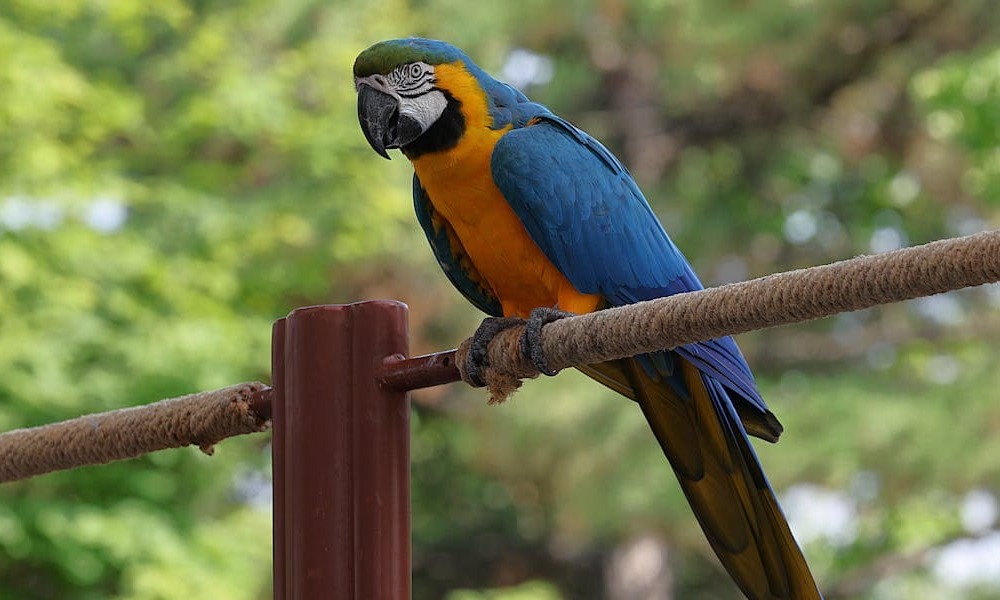Parrots are intelligent, social birds with complex needs. This guide covers enrichment strategies, noise management across species, and building healthy social bonds for happy, well‑adjusted feathered companions.
Understanding Parrot Intelligence and Social Nature
Parrots are among the most intelligent birds—equivalent to toddlers in problem‑solving and emotional complexity. In the wild, they live in flocks with intricate social hierarchies, constant communication, and foraging challenges.
- **Complex cognition:** Tool use, pattern recognition, emotional memory, and vocal learning.
- **Flock mentality:** Seek inclusion, react strongly to isolation or rejection.
- **Vocal communication:** Contact calls, alarm calls, and learned "words" serve social functions.
- **Long lifespan:** Many species live 20–80+ years, requiring lifelong commitment.
Daily Enrichment: Foraging, Problem‑Solving, and Play
Wild parrots spend 60‑80% of their day foraging. Captive birds need activities that engage their minds and bodies to prevent boredom and behavioral problems.
Foraging Enrichment
- Hide food in paper cups, tissue paper, or cardboard tubes.
- Stuff treats into pine cones, willow balls, or paper bags.
- Use puzzle feeders and rotating toys daily.
- Scatter feeding: sprinkle pellets on cage bottom with paper to dig through.
Destructible Toys
- Untreated wood blocks, bamboo, and cork for chewing.
- Paper towel rolls, phone books (no glossy pages), cardboard.
- Palm fronds, corn husks, and vine balls.
- Rotate toys weekly to maintain novelty.
Mental Challenges
- Training sessions: target training, turn around, wave, retrieve.
- Puzzle boxes with multiple steps to access treats.
- Music and videos designed for birds during alone time.
- Mirror time (supervised) for some species that enjoy reflection play.
Physical Exercise
- Large flight cage or daily out‑of‑cage time in a bird‑safe room.
- Climbing gyms with natural branches of varying diameters.
- Swings, ladders, and perches at different heights.
- Supervised flight time where safe and appropriate.
Noise Levels by Species: What to Expect
All parrots vocalize, but volume, frequency, and timing vary significantly. Understanding your species' natural patterns helps set realistic expectations.
Quieter Options (Apartment‑Friendly)
- **Cockatiels:** Moderate volume, morning/evening calls, whistling.
- **Bourke's Parakeets:** Very quiet, soft chatter, minimal screaming.
- **Senegal Parrots:** Moderate calls, less frequent than larger species.
- **Parrotlets:** Small but can be loud in short bursts; generally manageable.
Moderate Volume
- **Conures (Green‑Cheeked):** Playful chatter, occasional loud calls.
- **Caiques:** High energy with moderate volume, lots of chatter.
- **Quaker Parrots:** Talkative but not as loud as larger species.
- **Lovebirds:** Frequent chatter, higher pitched but not overwhelming.
Louder Species (House Required)
- **Sun Conures:** Very loud contact calls, especially morning/evening.
- **African Greys:** Moderate volume but excellent mimics, frequent talking.
- **Amazon Parrots:** Loud morning/evening calls, very vocal species.
- **Eclectus:** Moderate to loud, with distinct honking calls.
Loudest Species (Rural Ideal)
- **Macaws:** Extremely loud calls that carry for miles in nature.
- **Cockatoos:** Piercing screams, especially when seeking attention.
- **Large Conures:** Sun, Blue‑Crown, and Nanday are notably loud.
Managing Noise: Training and Environmental Strategies
- **Ignore attention‑seeking screams:** Don't approach, talk, or make eye contact during unwanted vocalizations.
- **Reward quiet behavior:** Offer treats, attention, or out‑of‑cage time when the bird is calm.
- **Establish quiet times:** Cover the cage or use a "quiet cue" consistently.
- **Provide morning routine:** Early interaction can reduce separation anxiety calls.
- **Background noise:** Gentle music or TV can mask some calling from neighbors.
- **Exercise and enrichment:** Well‑stimulated birds are generally calmer.
Social Needs: Bonding and Flock Dynamics
Parrots view their human family as their flock. Understanding their social structure helps build healthy relationships and prevent behavioral issues.
Building Trust
- Start with calm presence near the cage; let the bird approach you.
- Offer treats through cage bars before attempting hand‑feeding.
- Use target training to create positive interactions without forcing contact.
- Respect body language: fluffed feathers, pinned eyes, or lunging mean "back off."
Preventing Over‑Bonding
- Involve multiple family members in care and training.
- Rotate who feeds, handles, and trains the bird.
- Teach "step up" for different people, not just the primary caregiver.
- Avoid excessive petting, especially around the back and under wings (triggers hormonal behavior).
Creating a Bird‑Safe Environment
- **Remove dangers:** Teflon cookware, scented candles, ceiling fans, open water containers.
- **Secure windows and mirrors:** Birds can fly into glass or become obsessed with reflections.
- **Check plants:** Many houseplants are toxic to birds (avocado, chocolate, caffeine, onions).
- **Supervise out‑of‑cage time:** Watch for chewing on furniture, electrical cords, or small objects.
- **Air quality:** Avoid aerosols, strong cleaners, and smoking around birds.
Training Basics: Building Communication
- **Target training:** Teach the bird to touch a stick or finger with their beak for a treat.
- **Step up/step down:** Use a consistent cue and reward successful transfers.
- **Recall training:** Start close, use high‑value treats, practice in a bird‑safe room.
- **Trick training:** Simple behaviors like "turn around" or "wave" provide mental stimulation.
- **Vocalization control:** Teach "quiet" and "speak" cues to give structure to talking.
Signs of a Happy, Healthy Bird
- **Active and alert:** Curious about surroundings, interactive with humans.
- **Good appetite:** Eating variety of foods, maintaining steady weight.
- **Normal vocalizations:** Species‑appropriate calling, not excessive screaming.
- **Preening behavior:** Regular feather maintenance, smooth plumage.
- **Playful interactions:** Engaging with toys, people, and environment.
Red Flags: When to Consult an Avian Vet
- **Appetite changes:** Refusing food for more than 24 hours.
- **Feather problems:** Excessive plucking, bald patches, or abnormal molting.
- **Behavioral changes:** Sudden aggression, lethargy, or withdrawal.
- **Physical symptoms:** Breathing difficulties, discharge from eyes/nose, or sitting on cage floor.
- **Egg‑laying issues:** Chronic laying, egg‑binding, or reproductive problems.
Species‑Specific Considerations
Cockatiels
- Great beginner birds, moderate noise, enjoy head scratches.
- Males typically more vocal and outgoing than females.
- Watch for night frights and provide stable cage covering.
Conures
- Playful and social, moderate to loud depending on species.
- Need lots of interaction and can become nippy if bored.
- Green‑cheeks are quieter; sun conures are much louder.
African Greys
- Extremely intelligent, excellent talkers, sensitive to change.
- Need consistent routine and patient socialization.
- Prone to feather plucking if stressed or bored.
Cockatoos
- Affectionate but demanding, very loud, prone to hormonal issues.
- Need extensive socialization to prevent over‑bonding.
- Require experienced owners due to complex needs.

